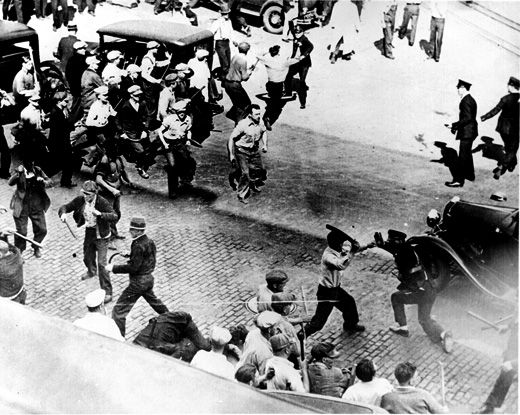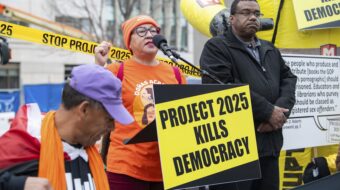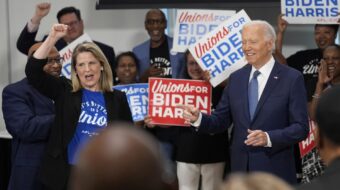
MINNEAPOLIS (PAI) — The tensions had been simmering for months in Minneapolis.
The Teamsters, trying to organize the city’s truckers – who were key to transportation of food and industrial goods all over the Upper Midwest – had been browbeaten by their bosses.
The so-called Citizens Alliance, a secret cabal of leading businessmen, was confident it could beat the Teamsters – particularly Local 574 – again. After all, the alliance’s virulent and sometimes violent anti-unionism had ruled labor relations in Minneapolis since the early 1900s.
This time, in 1934, it didn’t turn out that way.
Instead, the Citizens Alliance forced truckers to strike twice in 1934. The second, an 11-day strike starting on July 16, 1934, saw police to open fire on unarmed strikers – truckers who had brought 95 percent of Minneapolis’ freight shipments to a halt. Two strikers died from the police shotgun blasts and 65-67 more were wounded.
More importantly, the Minneapolis strike and a similarly violent business reaction to longshore workers’ demands in San Francisco woke the country up. Both struggles spread citywide. Some 35,000 Minneapolis building trades workers walked out, demanding recognition of their unions. Even the city’s taxi drivers joined in.
And those two general strikes in turn put pressure on what had been a reluctant Roosevelt administration to enact the National Labor Relations Act the following year.
The first break for the Teamsters, led by Vincent “Ray” Dunne, Ferrell Dobbs, Meridel Le Sueur and other “radicals,” was when coal company workers unexpectedly shut down 65 of the city’s 67 coal yards in February. The yard owners surrendered in three days and recognized the union, which is now Local 120. Membership zoomed from 100 to more than 5,000 in what was a general industrial union, most of them truckers and warehouse workers, according to a strike history on the Teamsters international union’s website.
Local 5474 then sought voluntary recognition from trucking firms, who refused. So the Minneapolis truckers called the first strike in May. They demanded recognition, wage hikes, shorter hours and the right to represent the warehouse and loading bay workers, too.
“The strike brought all trucking inside the city to a standstill. It also used some techniques that were not normally used in labor actions. Flying pickets were established and deployed from the union headquarters. They patrolled the streets in a vast fleet of cars and trucks to ensure that no scab trucks were on the move. They displayed a special union sign so as to prevent confusion,” the Teamsters website says.
One hundred strikers established a coordinating committee to handle strike action, arrange relief for families and even publish a newspaper, The Organizer, to get their message out citywide. The committee also reached out to the jobless who, in the Great Depression, comprised one-third of all Minneapolis workers.
The Minneapolis mayor was pro-business and did nothing to stop the first police violence against the workers, on May 19. Six days later, the employers said they would accept the truckers’ demands and the workers returned to their jobs. But by July, the trucking firms were obviously violating the agreement: They had fired 700 workers and refused to agree to recognize the union, which had signed up an overwhelming majority of the truckers.
So the truckers had to strike again, on July 17. And the police really got violent. They opened fire with shotguns on unarmed strikers on July 20. Strikers John Belor and Henry Ness were killed and 65-67 others were injured. Most were shot in the back. Ness’ funeral, days later, brought Minneapolis to a complete halt: 100,000 people jammed the streets.
“A public commission set up after the strike later reported that ‘Police took direct aim at the pickets and fired to kill. Physical safety of the police was at no time endangered. No weapons were in possession of the pickets,'” the history says.
Reluctantly, pro-worker Gov. Floyd Olson declared martial law, and ordered the National Guard to patrol Minneapolis, and let trucks bearing military permits through. “The union, seeing this as an attempt to break the strike, demanded all permits be revoked and in defiance of the martial law, the workers vowed again to return to the picket lines on Aug. 1.
“On the night of July 31, the union headquarters was surrounded and raided by the National Guard troops, who arrested many strike leaders. The union rank and file called a mass rally demanding release of the arrested leaders. Nearly 40,000 people marched on the stockade. The leaders were released and the captured union headquarters was surrendered.”
Three weeks later, the Citizens Alliance threw in the towel, after mediation prompted by closed-door briefings of both President Roosevelt and his top aides by union leaders, including the editor of the Minneapolis Labor Review. Teamsters Local 574 won, the alliance crashed, recognition elections were held at workplaces citywide, and the strike ended when the union won its major demands, such as raises through arbitration.
Much the same scenario occurred in San Francisco, where the longshore workers, under the leadership of Harry Bridges, saw two workers killed and dozens injured, the National Guard was called in and a general strike shut down the city. All this, plus worker action elsewhere, moved Sen. Robert Wagner, Sr., D-N.Y., to act. He believed and said, that giving workers the guaranteed right to organize and bargain collectively would lead to industrial peace – a justification for the law that still exists.
Wagner wrote the National Labor Relations Act (NLRA), the nation’s basic labor law, in early 1935, then convinced a reluctant Roosevelt to support it. The Senate passed the NLRA 63-12, the House approved it by voice vote, and Roosevelt signed it on July 5, 1935.
In the 1970s, KTCA Minneapolis produced a documentary on the strike. It can be viewed in two parts on YouTube.
Photo: Battle, strike 1934. Wikipedia, Public Domain












Comments